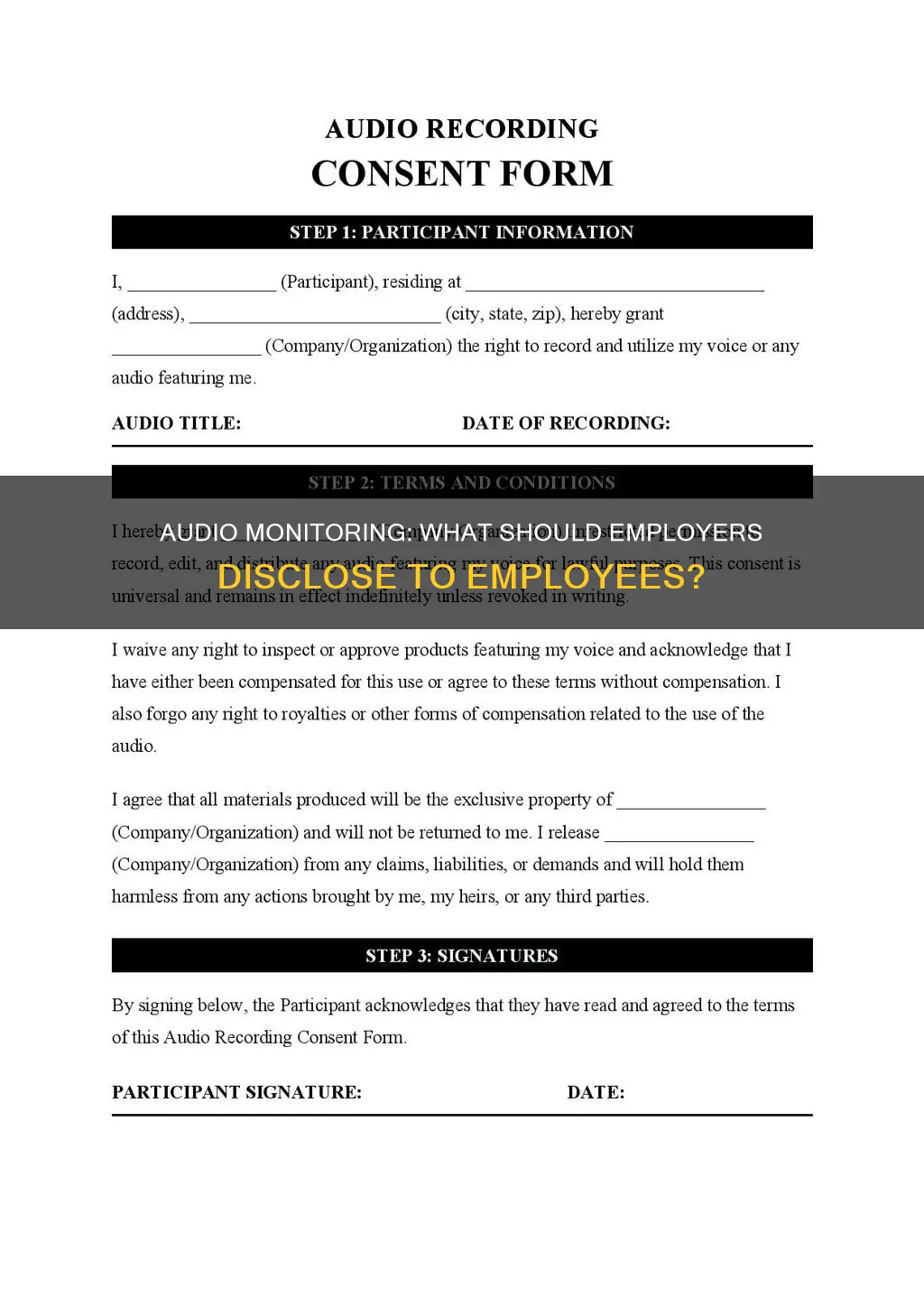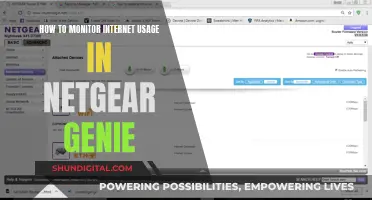
Employers can legally monitor almost anything an employee does at work, as long as there is a valid reason for doing so. This includes audio monitoring, which is permitted under the Electronic Communications Privacy Act (ECPA) of 1986. However, there are certain caveats to this.
While federal legislation does not require employers to disclose that they are monitoring their workers, some states have implemented laws that do. For example, Connecticut, Texas, New York, and Delaware require employers to notify their staff about the use of monitoring software. In addition, the ECPA states that employers must obtain consent from at least one party before monitoring and recording company phone calls. Several states require consent from all parties.
Employers should also be aware that monitoring employees without their knowledge or consent can lead to legal disputes and negatively impact employee morale.
What You'll Learn

Do I have to tell my employees about audio monitoring?
In the US, employee monitoring is completely legal. Federal and state laws allow employers to monitor anything that comes in and out of company-owned devices and across their network, particularly when there is a legitimate business intent. While there is no federal law requiring employers to inform their employees about audio monitoring, several states mandate this.
Connecticut, for instance, has had that law since 1998, and Delaware has had it since 2001. In May 2024, New York enacted a similar law. In addition, California is considering a measure that would go further, prohibiting employers from monitoring workers who are off duty or using personal devices, using facial-recognition technology, and keeping workers from viewing any data collected on them.
In the UK, employers have the right to monitor activities in many situations at work. Employers must take reasonable steps to inform their employees that monitoring is happening, what is being monitored, and why it is necessary—except in very limited circumstances.
Asus Monitor Issues: Why Won't It Pick Up?
You may want to see also

What are the risks of not telling employees?
Not disclosing audio monitoring to employees can have several risks for employers. Firstly, it can lead to legal consequences as some state and local laws mandate that employers inform employees about data monitoring. For example, the California Consumer Privacy Act (CCPA) and the impending California Privacy Rights Act (CPRA) have guidelines around the collection of user data and employee privacy notices.
Additionally, not being transparent about audio monitoring can damage the company culture and employee retention. Employees may feel like they are not trusted by the company, leading to lowered morale and productivity. This can be the exact opposite of what employers aim to achieve through monitoring.
Moreover, without informing employees, there is a risk of unintentionally recording private employee information, such as health records or bank account information. If the monitoring system gets hacked, this private data could be exposed, leading to potential litigation.
Furthermore, employees have a reasonable expectation of privacy, and not disclosing audio monitoring may result in invasion-of-privacy lawsuits arising under common law. Informing employees about monitoring reduces their privacy expectation and strengthens the employer's legal defence.
Finally, being transparent about audio monitoring helps build trust with employees and can reduce the potential negative impact on company culture and employee retention.
Removing Black Spots from Your LCD Monitor
You may want to see also

What are the benefits of audio monitoring?
While audio monitoring in the workplace is legal, it is not required by law in most places. However, there are several benefits to implementing audio monitoring in the workplace.
Increased Productivity
Research shows that when employees are aware of being monitored, their productivity increases by 7%, resulting in higher profits for the organization. They tend to stay focused on their tasks and minimize time-wasting activities. According to a study by the American Management Association, organizations that implemented employee monitoring reported an average productivity increase of 22%.
Enhanced Security
Employee monitoring tools can help organizations detect and prevent security breaches, data leaks, and other unauthorized activities. For example, by monitoring employees’ internet usage, organizations can identify and block access to risky websites, preventing potential security threats.
Prevention of Insider Threats
Insider threats, such as employees stealing company data or other employee information, can be detrimental to an organization’s reputation and finances. Monitoring employees can help detect and prevent such threats by identifying any suspicious behavior, such as unauthorized data access or downloads, and raising alerts for further investigation.
Identifying and Resolving Performance Issues
Employee monitoring can provide insights into employees’ performance and help identify any performance issues. By tracking employees’ activities, employers can assess their productivity levels, identify any gaps in skills or training, and provide appropriate feedback and coaching to improve performance.
Time and Resource Management
Employee monitoring can help organizations optimize their resource allocation by identifying time-wasting activities, streamlining workflows, and identifying any bottlenecks or inefficiencies in processes. This can result in better time management, improved resource allocation, and increased overall productivity.
Remote Employee Monitoring
With the rise of remote work, monitoring remote employees’ activities can ensure they are engaged, productive, and adhering to company policies. It can also help remote employees stay focused and avoid distractions, leading to improved productivity and performance.
Employee Accountability
Employee monitoring promotes accountability in the workplace. By tracking employees’ activities, organizations can ensure that employees are fulfilling their responsibilities and meeting their targets. Monitoring tools can provide data and metrics to measure employees’ performance and hold them accountable for their work, leading to a culture of accountability.
Protection of Company Reputation
Employee monitoring can help protect the company’s reputation by identifying any activities that may pose a risk to the organization’s image or brand. Monitoring tools can detect any inappropriate behavior, such as sharing sensitive information, and take appropriate measures to address them, safeguarding the company's reputation and maintaining a positive image.
Employee Training and Development
Employee monitoring can be used for employee training and development. By tracking employees’ activities, organizations can identify areas where employees may need additional training or support, and tailor their training programs to address specific needs, resulting in improved employee skills and increased job satisfaction.
Enhanced Communication and Collaboration
Effective communication and collaboration are essential for organizational success. Employee monitoring can facilitate communication and collaboration among team members by providing insights into their activities and interactions. Monitoring tools can help identify any communication gaps or breakdowns, enabling organizations to take corrective actions and improve team dynamics, resulting in better teamwork and increased innovation.
Addressing Insider Threats
Insider threats, such as employees leaking sensitive information or engaging in unethical activities, pose a significant risk to organizations. Employee monitoring can help detect any suspicious activities or behavioral patterns that may indicate insider threats. By monitoring employees’ activities, organizations can identify potential red flags and take appropriate measures to prevent any harm to the company, including implementing security protocols or taking legal actions.
Improved Compliance with Industry Regulations
Employee monitoring can help ensure that organizations comply with industry-specific regulations and legal requirements. Monitoring tools can track and document employee activities to ensure that all processes are conducted according to data protection, privacy, and operational standards. This reduces the risk of non-compliance, which can result in costly fines and legal repercussions.
Better Workload Management and Balanced Work Distribution
Employee monitoring can assist in managing workloads more effectively by providing insights into how tasks and responsibilities are distributed among employees. Monitoring tools can reveal which employees are overburdened and identify those with the capacity to take on additional tasks, enabling managers to distribute work more evenly, prevent burnout, and ensure efficient utilization of all employees.
Evidence for Dispute Resolution
Employee monitoring can provide valuable evidence for dispute resolution. For example, in the case of an employee violating safety regulations, video evidence can protect the organization from legal costs if the employee sues. Monitoring can also help identify employees violating company policies and enforce disciplinary measures.
Safety Measures
Employee monitoring can help identify safety issues and hazards in the workplace, especially in environments prone to safety hazards, such as warehouses and construction sites. By addressing these issues promptly, organizations can avert danger and protect their employees.
Spotting Employee Strengths and Weaknesses
Employee monitoring allows employers to observe how employees are performing their tasks and identify areas where they are excelling or falling short of expectations. This information can be used to provide recognition and feedback, improving employee morale and performance.
Setting Up Apple Monitor: A Step-by-Step Guide
You may want to see also

What are the laws on audio monitoring?
The laws on audio monitoring in the workplace vary depending on the jurisdiction. In the United States, for example, while there is no federal requirement to disclose monitoring to employees, some state laws mandate this, such as in Connecticut, Delaware, Texas, and New York.
At the federal level in the US, the Electronic Communications Privacy Act (ECPA) regulates audio surveillance in the workplace. The ECPA prohibits the interception of electronic communications without the consent of at least one party. However, there is a "business extension" exception, which allows employers to intercept calls on company phones for business purposes.
State laws may impose additional restrictions on audio monitoring. For example, some states require the consent of all parties to a communication for audio monitoring to be legal, while others mandate that employees are notified if they are being monitored.
In the UK, employers are required to take reasonable steps to inform employees that monitoring is taking place, what is being monitored, and why it is necessary, except in limited circumstances.
Regardless of the jurisdiction, it is generally recommended that employers have clear and well-defined policies in place regarding audio and other types of monitoring, and that employees are made aware of these policies.
Water Usage Monitoring: A Standard Practice in Hotels?
You may want to see also

What are the alternatives to audio monitoring?
There are several alternatives to audio monitoring in the workplace, including:
- Video monitoring systems: This is legal in most states in the US, as long as there is a legitimate business purpose for doing so. However, there are areas where video monitoring is prohibited, such as restrooms, locker rooms, and other areas where employees have a reasonable expectation of privacy.
- Email monitoring: Employers can monitor business emails, and in some states, they are required to obtain consent from third parties before accessing employees' emails.
- Computer monitoring: Employers can monitor company-owned computers and laptops, including internet usage, downloads, and active/idle time. However, if employees use their personal computers for work, employers must obtain their written consent to monitor these devices.
- GPS tracking: Employers can use GPS to track company cars and the geolocation of employees using company devices. However, tracking an employee's location outside of work hours without their prior consent is considered spying and is illegal.
- Keylogging: This method tracks every keystroke typed per hour on a work computer. While this is legal in the US, it may be considered too invasive and a violation of employee privacy in some states.
- Content blocking: Employers can block employees from accessing certain websites and online content that are considered unproductive or harmful.
- USB and print monitoring: This method tracks when employees insert external devices such as thumb drives into company computers, as well as when they print, download, or upload files. This can help prevent data leaks and ensure that employees are not engaging in harmful or unproductive activities.
- Network monitoring: This method involves tracking the functionality of network components such as firewalls and routers to reduce network downtime and improve cybersecurity.
- Performance management software: This type of software can be used to track employee performance, set goals, and provide feedback. It often includes features such as custom review cycles, goal tracking, and peer feedback.
While these alternatives to audio monitoring exist, it is important to note that the legality and ethical considerations of employee monitoring vary across different jurisdictions. Employers should consult legal experts and establish clear policies to ensure that any form of employee monitoring is carried out in a transparent and non-invasive manner.
Deleting Frames on Your ASUS Monitor: A Step-by-Step Guide
You may want to see also
Frequently asked questions
Not necessarily. While there is no federal law requiring information or consent for audio monitoring, several states do mandate it. For example, Connecticut, New York, and California have laws that require employers to inform employees about audio monitoring.
No, employers are not required to obtain consent to implement monitoring. However, some states require employers to obtain consent from employees. These include Connecticut, Delaware, Texas, and New York.
Violating monitoring laws can result in lawsuits, fines, and damage to the employer's reputation. In some cases, it may even lead to criminal liability.
Audio and video recording can be used to identify harassment and resolve workplace conflicts. It can also be used to gain insight into efficiency and workplace productivity.
Yes, employers should not install audio monitoring devices in places where there is a reasonable expectation of privacy, such as restrooms, locker rooms, or dressing rooms. Federal wiretapping law also prohibits employers from recording employees' personal calls or accessing their voicemails without express permission.







